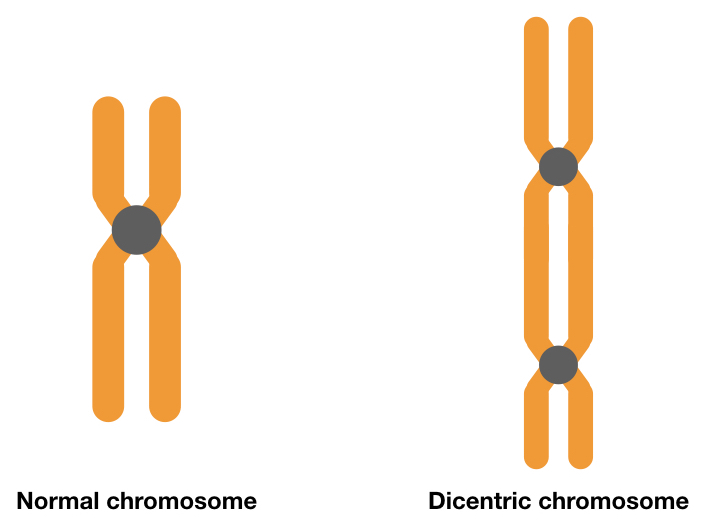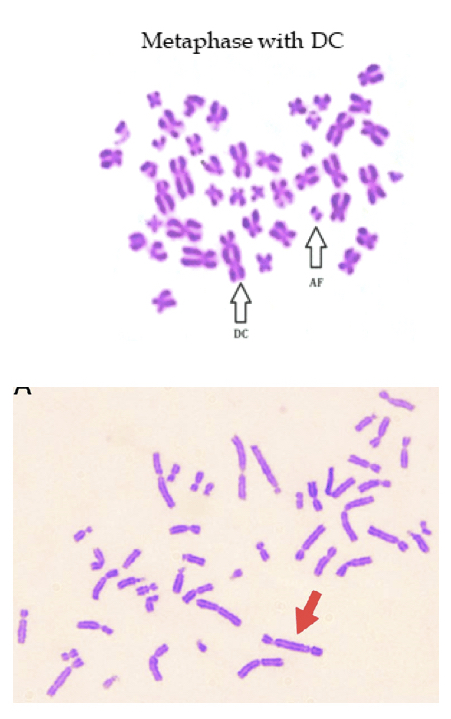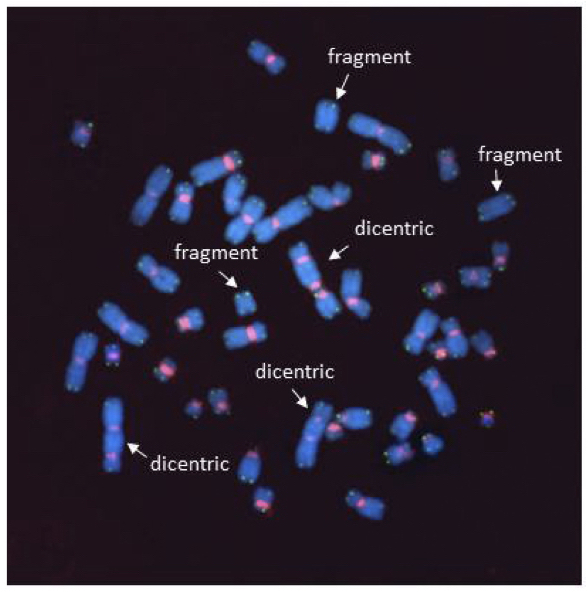The dicentric chromosome is a highly uncommon event that occurs in the genome which causes genomic instability and cancer.
We have written many articles on common chromosome aberrations or chromosomal abnormalities such as a change in number, deletion, duplication and translocation.
These are common, studied well and can be identified easily using the conventional karyotyping technique. However, abnormalities such as ring chromosome or dicentric chromosome are certainly so uncommon.
In addition, those alterations are hard to identify and have a wide range of phenotypic effects. We are studying cytogenetics and karyotyping on this blog, so we need to understand those aberrations as well.
Though very rare and uncommon, we are trying to explain to you the mechanism, cause and consequences of such conditions. Here is the article on one of the most uncommon and rare genetic conditions “dicentric chromosome.”
What is a dicentric chromosome?
The first case of the dicentric chromosome was reported in 1986 in a military person who was exposed to radiation. The present condition often occurs by inversion and translocations such as Robertsonian translocation.
Noteworthy, few are reported either due to telomere instability and irradiation. It is the condition in which two chromosomes fuses and forms a state having two different centromeres, however, another chromosome remains unicentric or lacks centromere.

Definition:
“When a chromosome has two centromeres which cause genetic instability and cancer condition due to some unknown event occurring during cell division, the condition is known as a dicentric chromosome.”
Before going ahead we need to briefly understand the structure of chromosomes and centromeres.
Chromosomes are the X-shaped structure, which has arms, telomere and centromere. The centromere is a central, dark and untranscribed region of the chromosome that helps to segregate chromosomes correctly during replication.
We can say, it is a structure made up of proteins and DNA, the DNA sequences present here are tightly wrapped henceforth, are transcriptionally inactive.
Nucleotide sequences present on centromere are repetitive, though can’t form any protein but regulates gene expression.
Proteins present in it also provide binding sites for kinetochores during metaphase segregation. As it regulates gene expression and inheritance of chromosomes during replication, centromeric DNA is important for stabilizing a genome (genomic stability).
So clearly, in a dicentric condition, all these mechanisms get disturbed. Notably, the chromatids present at centromere are a type of constitutive heterochromatin, which will never be expressed.
We need everything doubled. More is always good, we always wonder, but here is not a case, doubled centromere present on a chromosome and in the genome isn’t favorable to us, indeed.
Now let’s check it out, how actually it forms.
How are dicentric chromosomes formed?
As we noted, inversion and translocation are two natural phenomena to cause a dicentric chromosome, while radiation and telomere instability are two more.
Paracentric inversion occurs without involving a centromere, meaning, after the meiotic, I cell division a kind of dicentric and unicentric chromosomes formed.
At a molecular level, dsDNA break occurs between the two non-homologous chromosomes and produces sticky ends. Later on, those fragments are recombined at ends and produce acentric fragments and a dicentric chromosome.
Chromosome breakage cause inversion or rotation of chromosome parts is known as inversion. When the dicentric chromosome enters into anaphase, the dicentric chromosome is pulled apart and may result in segmental aneuploidy in newly formed cells.
Telomere dysfunction or shortening is another reason that forms a dicentric chromosome by recombined of fusing with another chromosome. The telomere is a structure that protects the fusion of chromosome ends, meaning, to maintain the integrity of each chromosome.
Irradiation is yet another reason for the same. When cells exposed to radiation, chromosomes produce the dicentric structure, those dicentrics are highly unstable. Based on the number of dicentric chromosomes formed the dose and intensity of radiation can be studied, in vitro.
What are the consequences of a dicentric chromosome?
Forming a dicentric chromosome is a highly unnatural event that causes wide varieties of problems in the human genome.
Genomic Instability:
Firstly, it induces other chromosomal abnormalities such as deletion/ duplication– copy number variation. Although phenotypic effects of such conditions are also varied.
Genomic instability is the most common consequence of this. chromosomal instability or genetic instability occur when the gene expression pattern of the genome changed or altered.
As indicated somewhere in this article, centromeric- repetitive DNA regulates gene expression. Meaning, in a unicentric chromosome- lacking a centromere dysregulates the whole mechanism.
Whilst in the dicentric one, it may doubled (gene expression increases).
Dicentric chromosome and cancer:
Dicentric chromosomes are reported in varieties of cancer and malignancy. This occurs because of genomic instability or chromosome fusion. Studies reveal that the present condition is more commonly observed in acute myeloid leukemia.
Here are some of the dicentric chromosomal abnormalities and their related cancer conditions.
| Dicentric chromosome | Abnormality |
| dic(1;15)(p11;p11) | Myeloid malignancies |
| dic(3;9)(p14;p13) | Acute lymphoblastic leukemia |
| dic(5;17)(q11-14;p11-13) | Chronic myeloproliferative neoplasm and acute myeloid leukemia |
| dic(7;9)(p11-12;p12-13) | Acute lymphoblastic leukemia |
| dic(7;9)(p11-13;p11) | Acute lymphoblastic leukemia |
| dic(7;12)(p10-12;p11-13) | B-cell ALL |
| idic(7)(q11.2) | Acute myeloid leukemia |
| dic(9;12)(p13;p13) | Lymphoblastic leukemia/lymphoma |
| dic(9;12)(p13;p12) | Acute lymphoblastic leukemia |
| dic(9;16)(p13;q11) | Acute lymphoblastic leukemia |
| dic(9;17)(p13;q11) | Acute lymphoblastic leukemia |
| dic(9;18)(p13;q11) | Acute lymphoblastic leukemia |
| dic(9;20)(p11-13;q11) | Acute lymphoblastic leukemia |
| dic(17;20)(p11.2;q11.2) | De novo acute myeloid leukemia and myelodysplastic syndrome |
| idic(X)(q13) | AML, myelodysplastic syndrome and chronic myeloproliferative disease |
In a broad sense, we can say, that the dicentric aberration leads to a change in copy number variation, meaning, segmental deletion-duplication alters the genetic composition of a cell or chromosome itself which is the main reason for the involvement of the dicentric chromosome in cancer.
However, in sporadic dicentric conditions, cells natural repair mechanism inactivates another centromere automatically and regulates gene expression- prevent genomic instability.
Karyotyping of dicentric chromosome:
The conventional karyotyping procedure is more than enough to rule out conditions such as dicentric or ring chromosomes. Along with GTG banding, centromeric banding, or C-banding helps a lot during the investigation.
C-bands are specialized banding techniques designed to stain the constitutive heterochromatin region of a genome, i.e the centromere. Meaning, the centromere can be studied well. If you wish to read more on the present topic you can read it here:
- What is C banding?- Requirement, Process, Protocol and Applications
- GTG banding- G bands using trypsin

First image courtesy:
Perumal, Venkatachalam & Selvan, Dr. G. & Raavi, Venky & Basheerudeen, Safa & Kanagaraj, Karthik & Chowdhury, Amith & Paul, Solomon. (2015). Radiation signature on exposed cells: Relevance in dose estimation. World journal of radiology. 7. 266-78. 10.4329/wjr.v7.i9.266.
Second image courtesy:
Ariyoshi, Kentaro & Suzuki, Keiji & Goto, Makoto & Watanabe, Masami & Kodama, Seiji. (2007). Increased Chromosome Instability and Accumulation of DNA Double-strand Breaks in Werner Syndrome Cells. Journal of radiation research. 48. 219-31. 10.1269/jrr.07017.
Researchers also use fluorescent in situ hybridization for cancer studies, dicentric chromosomes are observed when using the centromeric probes. The probes hybridize to the constitutive heterochromatin regions and emit fluorescence.

Wrapping up:
Much like the ring chromosome, the dicentric aberration is uncommon too in a human genome. No clear symptoms of the condition are reported as cases of de novo dicentric aberrations are less.
Though mental retardation, neurological problems, physical disabilities and intellectual problems are reported.
In addition, in vitro ring chromosome studies are the “Gold standard” method to measure the dose of radiation in various experiments. The amount of dicentric chromosomes formed is directly proportional to the radiation dose.

